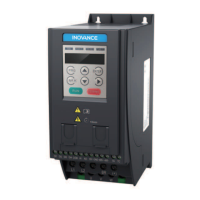CANopen & CANlink Communication
‑59‑
RPDO
Address of Parameter in
Group AF
TPDO
Address of Parameter in
Group AF
RPDO3
Sub‑index 1
AF‑16 TPDO3
Sub‑index 1
AF‑48
AF‑17 AF‑49
Sub‑index 2
AF‑18
Sub‑index 2
AF‑50
AF‑19 AF‑51
Sub‑index 3
AF‑20
Sub‑index 3
AF‑52
AF‑21 AF‑53
Sub‑index 4
AF‑22
Sub‑index 4
AF‑54
AF‑23 AF‑55
RPDO4
Sub‑index 1
AF‑24 TPDO4
Sub‑index 1
AF‑56
AF‑25 AF‑57
Sub‑index 2
AF‑26
Sub‑index 2
AF‑58
AF‑27 AF‑59
Sub‑index 3
AF‑28
Sub‑index 3
AF‑60
AF‑29 AF‑61
Sub‑index 4
AF‑30
Sub‑index 4
AF‑62
AF‑31 AF‑63
Each PDO can be configured with four mappings. To configure one mapping, you
need to operate on two parameters in group AF to implement 32‑bit data, of which
the high‑order 16 bits (with a smaller parameter No,) are the object dictionary index,
and the low‑order 16 bits (with a larger parameter No.) are the object dictionary sub‑
index and object length. The object length is calculated in bits. The mapping object
format is as follows: 311615870.
Index Sub‑index Object Length
High‑order bits of the
parameter in group AF
Low‑order bits of the
parameter in group AF
‑
To map a parameter to a PDO, you need only to write the object dictionary index and
sub‑index corresponding to the parameter as well as the data length to the parameter
in group AF based on the preceding rules.
For example, to configure two mappings for RPDO1, one points to F0‑01 and the other
is an object dictionary object 0x6060‑00, do as follows:

